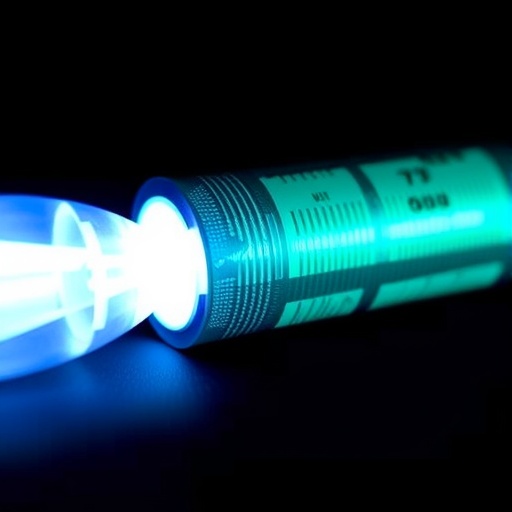In the quest for innovative energy storage solutions, the research field of alkaline batteries continues to evolve, leading to groundbreaking discoveries in material properties that can optimize performance. A recent study undertaken by Wang et al. explores the potential of a newly engineered alloy anode composed of aluminum, gallium, bismuth, tin, and lead, specifically formulated as Al-0.05Ga-0.15Bi-0.15Sn-0.025Pb. This innovative composition aims to elevate the efficiency of alkaline square Al-air batteries, which have been recognized for their capabilities in providing sustainable and efficient energy.
Alkaline batteries, particularly Al-air types, have garnered attention due to their high energy density and reliance on abundant materials. The unique combination of aluminum with other elements such as gallium and bismuth can potentially enhance not only the electrical conductivity of the anode but also its electrochemical stability. The research conducted by Wang and colleagues carefully examines these properties, systematically evaluating the effects of each alloying element on battery performance, longevity, and environmental impact.
The study emphasizes the significant role that the chosen alloying elements play in influencing the electrochemical behavior of the Al-air battery. Aluminum, as the primary constituent, provides a lightweight and energy-rich foundation, while the addition of gallium can improve the alloy’s corrosion resistance and mechanical properties. Furthermore, bismuth is known to contribute to the enhancement of the anodic reaction kinetics, thus facilitating more proficient energy conversion during battery operation.
The experimental design of the study details a meticulous approach to assessing the electrochemical performance of the Al-0.05Ga-0.15Bi-0.15Sn-0.025Pb alloy. Tests were conducted to evaluate the battery’s capacity, voltage output, and overall efficiency under various operating conditions. The research team also analyzed the thermal stability of the alloy, recognizing its importance in the broader context of battery application, where temperature fluctuations can adversely affect performance.
The results from Wang and colleagues provide a promising outlook on the usability of the Al-0.05Ga-0.15Bi-0.15Sn-0.025Pb alloy. Charge-discharge tests indicate that this new anode material exhibits superior performance metrics compared to traditional anodes used in Al-air batteries. The findings illuminate pathways for further research that could focus on fine-tuning the alloy composition to maximize efficiency while reducing the environmental footprint.
In addition to performance enhancements, the study addresses the sustainability aspects of utilizing such alloys as anode materials. As society increasingly demands greener solutions for energy production and storage, the reduction in heavy metals and reliance on more abundant resources become paramount. By employing materials that are less toxic and more readily available, researchers are charting a course towards batteries that are both efficient and ecologically sound.
The significance of this research extends beyond academic circles; it addresses major industrial concerns about how to keep pace with the growing energy demands of modern technology. With the proliferation of electric vehicles and renewable energy systems, the need for efficient and durable battery solutions has intensified. The Al-air battery represents a strong candidate for meeting these challenges, and innovations in its anode materials could pave the way for comprehensive advancements in battery technology.
Moreover, the study shines a light on the importance of collaborative research efforts that bring together various expertise areas, from materials science to electrochemistry. The interdisciplinary approach adopted by Wang et al. underscores the need for cooperative problem-solving in tackling complex challenges in energy storage solutions. This collaborative spirit is set to inspire further innovative research across the scientific community.
Emerging from this research is the potential impact of these findings on future technology. As industries look toward integrating sustainable practices into their operations, the advancements in Al-air battery technology could create new opportunities for green energy initiatives. Companies may seek to adopt such battery technologies in their products, enhancing energy storage capacity while minimizing waste.
Ultimately, the efforts by Wang and his team represent a significant step towards the practical application of advanced materials in energy storage systems. With ongoing research and development, the vision of using eco-friendly, high-performance batteries may soon become a reality, enabling a greener future powered by sustainable energy solutions.
In conclusion, the study on the Al-0.05Ga-0.15Bi-0.15Sn-0.025Pb alloy anode for alkaline square Al-air batteries is an exciting development in the field of energy storage. The promising results indicate a pathway forward not only for improving battery performance but also for advancing environmentally friendly technologies that could transform how we store and use energy.
Subject of Research: Properties of Al-0.05Ga-0.15Bi-0.15Sn-0.025Pb alloy anodes for alkaline square Al-air batteries.
Article Title: Study on properties of Al-0.05 Ga-0.15Bi-0.15Sn-0.025Pb alloy anode for alkaline square Al-air battery.
Article References:
Wang, J., Liu, S., Sun, Y. et al. Study on properties of Al-0.05 Ga-0.15Bi-0.15Sn-0.025Pb alloy anode for alkaline square Al-air battery.
Ionics (2025). https://doi.org/10.1007/s11581-025-06637-y
Image Credits: AI Generated
DOI: https://doi.org/10.1007/s11581-025-06637-y
Keywords: Al-air battery, energy storage, alloy anode, electrochemical performance, sustainable energy solutions.
Tags: Al-Ga-Bi-Sn-Pb alloyalkaline air batteriesalloying elements influencealuminum alloy anodesbattery performance optimizationcorrosion resistance in batterieselectrochemical stabilityEnergy Storage Solutionsenvironmental impact of batterieshigh energy density batteriesinnovative battery materialssustainable energy technologies





